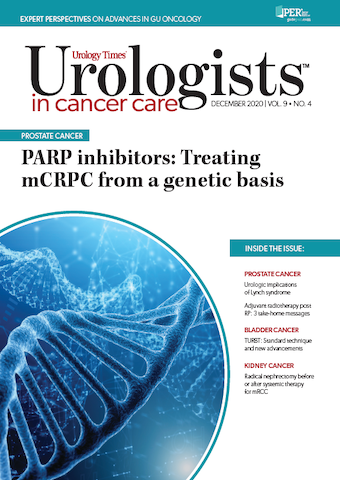Publication
Article
Urology Times Urologists in Cancer Care
The promise of precision medicine for urologic cancers
Author(s):
"As we slowly move toward the promise of precision medicine, it is important to understand fully this concept and the importance of testing and how it is to be used for diagnosis, management, and risk assessment," writes Raoul S. Concepcion, MD, FACS.
As we move into the last quarter of 2020, although much of the news has been dominated by the challenges of adapting to the ongoing coronavirus disease 2019 (COVID-19) pandemic and associated lockdown, as well as the most recent election, there have been some real breakthroughs as we continue our march toward precision medicine in cancer care. When I brought this term up the other day in conversation with a friend in the music industry, his comment was, “I hear this all the time from acquaintances and in the press, but what does this mean and what is its effect in benefiting patients?”
It is my hunch that most people, in and out of the health care world, have this basic question without true clarity as to its importance and profound impact on the treatment of patients with benign or malignant conditions. For urologists, there is no question that the global work in prostate cancer has led the way, primarily due to the sheer number of patients across the spectrum of disease that are available to study. All urologists understand the importance of the Gleason grading system and the association of aggressiveness and possible disease progression for those with higher Gleason scores. In fact, current National Comprehensive Cancer Network risk stratification is based, for the most part, on this parameter—basic histopathology, cellular architecture and appearance under the microscope, which our anatomic pathologists are skillfully trained to identify. For car aficionados, it is akin to the ability on inspection to differentiate between a Ferrari versus a Lamborghini versus a Ford Mustang.
But keeping with the car analogy, what makes these cars (prostate cancer) so vastly different in performance and value (currently measured by Gleason)? They all have engines, drive trains, tires, exhaust, etc (androgen receptors), but with rare exceptions, the price of 1 Italian supercar is equivalent to a minimum of 4 or 5 iconic American ponies. Thus, to really understand why certain individuals spend vast sums of money for, in its most simplistic definition, a transportation vehicle, it behooves one to have a complete working knowledge of what it takes to build and design the components that make these high-priced motorcars so unique and desired.
We are finally gaining on our understanding of the major molecular drivers that are responsible for the progression of the disease beyond Gleason. Poly (ADP-ribose) polymerase (PARP) inhibitors in the management of heavily treated metastatic castrate–resistant prostate cancer (mCRPC) received FDA approval in 2020. However, for our patients to receive these agents, it mandates that the physician order genomic testing for mutations in DNA damage repair genes involved in homologous recombination. In a similar fashion, testing for variants in mismatch repair genes might allow the use of specific immunotherapies/checkpoint inhibitors, just as an identified splice variant mutation of the androgen receptor, measured by circulating tumor cells, could point us down the therapeutic pathway of who might respond to taxane chemotherapy. In less than 10 years, we have progressed a long way from the days we initiated therapy solely based on the presence of a metastatic lesion and rising prostate-specific antigen.
A highly anticipated new line of precision medicine–based treatment for mCRPC, which we hope will be approved soon, is radioligand PSMA targeted therapy. The use of radiopharmaceuticals for both palliation and prolonged survival in the management of bone metastasis has been readily available for more than 2 decades. However, the development of a “theranostic” approach, based on the patient’s expression of PSMA detected on molecular imaging, represents yet another therapeutic option that is predicated not just on the presence of abnormalities based on traditional nonspecific bone scans but also on actual tumor activity that requires advanced imaging technique. It’s worth noting that on December 1, the FDA approved Gallium 68 PSMA-11 for PET imaging of PSMA-positive lesions in men with prostate cancer.
As previously mentioned, this quest to identify key genetic mutations, and ultimately targeted therapies, is not strictly confined to oncology and malignant transformation. Amyotrophic lateral sclerosis (Lou Gehrig disease) is a devastating progressive neurogenerative disorder, uniformly fatal. However, identification of subtypes, based in part on newly identified genetic mutations, hopefully will result in therapies that can delay progression.1
As we slowly move toward the promise of precision medicine, it is important to understand fully this concept and the importance of testing and how it is to be used for diagnosis, management, and risk assessment for the family. We will have to get comfortable in the vast lexicon associated with genomic classification and begin to think in terms of mechanistic pathways, not just the disease. After all, who would not want the chance to drive and hear the roar of an Italian racing machine?
Concepcion, director of the Comprehensive Prostate Center and clinical associate professor of urology at Vanderbilt University School of Medicine, Nashville, Tennessee, is editor-in-chief for Urologists in Cancer CareTM.
Reference
1. van Es MA, Hardiman O, Chio A, et al. Amyotrophic lateral sclerosis. Lancet. 2017;390(10107):2084-2098. doi:10.1016/S0140-6736(17)31287-4






